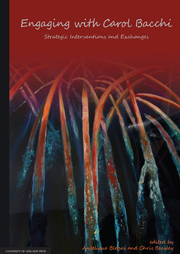Book contents
- Frontmatter
- Contents
- Acknowledgements
- List of Contributors
- Introduction
- Part I Looking back: On beginning
- Part II Strategic interventions and exchanges: Reflections and applications of the ‘What's the Problem Represented to be?’ approach
- 2 Introducing the ‘What's the Problem Represented to be?’ approach
- 3 Women, Policy and Politics: Recasting policy studies
- 4 Spaces between: Elaborating the theoretical underpinnings of the ‘WPR’ approach and its significance for contemporary scholarship
- 5 Digging deeper: The challenge of problematising ‘inclusive development’ and ‘disability mainstreaming’
- 6 Answering Bacchi: A conversation about the work and impact of Carol Bacchi in teaching, research and practice in public health
- 7 Located subjects: The daily lives of policy workers
- Additional interventions: Select reading list
- Part III Strategic exchanges: The wider context
- Part IV Looking forward: Still engaged
7 - Located subjects: The daily lives of policy workers
from Part II - Strategic interventions and exchanges: Reflections and applications of the ‘What's the Problem Represented to be?’ approach
Published online by Cambridge University Press: 05 June 2013
- Frontmatter
- Contents
- Acknowledgements
- List of Contributors
- Introduction
- Part I Looking back: On beginning
- Part II Strategic interventions and exchanges: Reflections and applications of the ‘What's the Problem Represented to be?’ approach
- 2 Introducing the ‘What's the Problem Represented to be?’ approach
- 3 Women, Policy and Politics: Recasting policy studies
- 4 Spaces between: Elaborating the theoretical underpinnings of the ‘WPR’ approach and its significance for contemporary scholarship
- 5 Digging deeper: The challenge of problematising ‘inclusive development’ and ‘disability mainstreaming’
- 6 Answering Bacchi: A conversation about the work and impact of Carol Bacchi in teaching, research and practice in public health
- 7 Located subjects: The daily lives of policy workers
- Additional interventions: Select reading list
- Part III Strategic exchanges: The wider context
- Part IV Looking forward: Still engaged
Summary
I remember sitting in the Napier Building's lecture theatre at The University of Adelaide in Carol Bacchi's undergraduate course as she developed her ‘What's the Problem Represented to be?’ approach to policy studies. I wondered at how it could even be contentious that policy solutions represented problems in particular ways that could be otherwise (Bacchi 1999)—her insights seemed so clear, so well argued, and so consistent with the way I understood the world. I also recall determining a few years later that the only way I would pursue my higher degree in Politics would be if Carol would agree to be my supervisor—which thankfully she did. This chapter, which is based on my PhD research, is, I think, an attempt to discern what the ‘What's the Problem Represented to be?’ approach might look like in practice. Here, I both offer a synthesis of my key findings and explain how they stem from Carol Bacchi's groundbreaking research. In doing so, I hope, to pay tribute to Carol the teacher and mentor as well as Carol Bacchi the fine thinker.
In this chapter I use Bacchi's distinction between rational policy-making—the assumption that there is a pre-existing problem in the world that we can identify and solve— and a recognition that policies represent problems in particular ways that have effects on people and social relations (policy-as-discourse). The ‘What's the Problem Represented to be?’ approach is premised on and develops this latter understanding of policy. As noted, in approaching my research I was interested in exploring what a policy-as-discourse approach to policy might look like in practice.
- Type
- Chapter
- Information
- Engaging with Carol BacchiStrategic Interventions and Exchanges, pp. 79 - 94Publisher: The University of Adelaide PressPrint publication year: 2012
- 3
- Cited by

